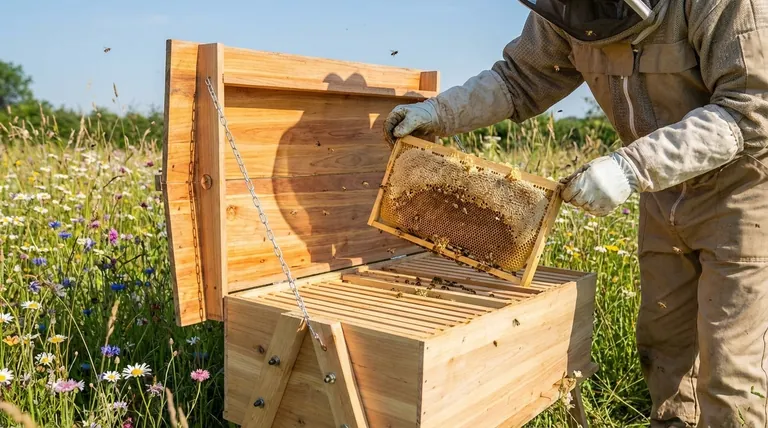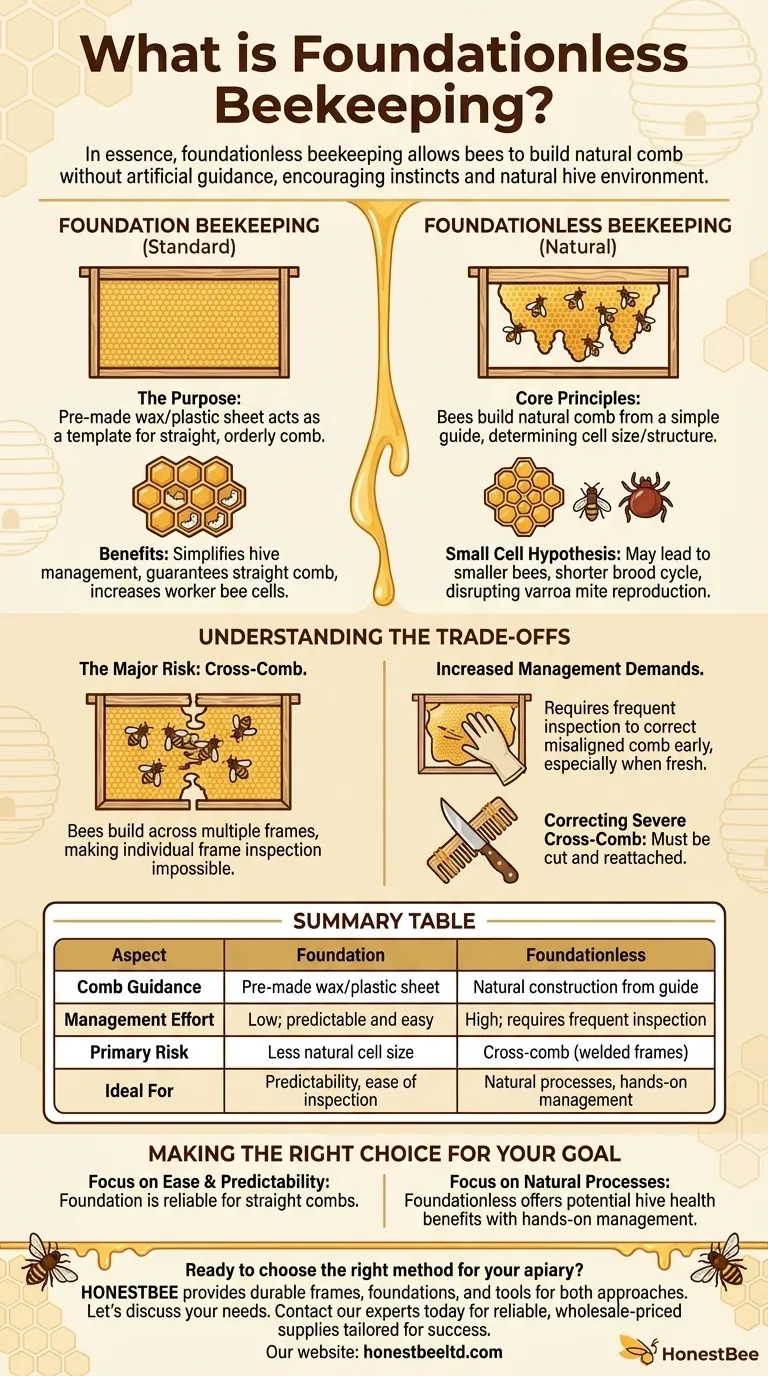In essence, foundationless beekeeping is a method where you allow bees to build their comb naturally within a frame, without the artificial guidance of a pre-made wax or plastic foundation. This approach encourages the bees to construct comb according to their own instincts, which can result in different cell sizes and a more natural hive environment.
While foundationless beekeeping offers the potential benefit of disrupting the varroa mite life cycle through natural cell sizes, it requires significantly more hands-on management to prevent the critical issue of "cross-comb," where bees build erratically across frames.

What is "Foundation" in Standard Beekeeping?
The Purpose of a Foundation
In most beekeeping operations, beekeepers use foundation—a thin sheet of pressed wax or plastic imprinted with a hexagonal pattern.
This foundation is inserted into a wooden frame and acts as a template. It provides a guide that ensures bees build straight, orderly comb.
The Benefits of Using Foundation
Foundation was developed to simplify hive management, particularly for large-scale apiaries.
It guarantees straight comb, which makes frames easy to remove for inspection. It also encourages bees to build a higher proportion of worker bee cells, which are essential for raising the colony's workforce.
The Core Principles of Foundationless Beekeeping
Encouraging Natural Comb Construction
The primary goal of going foundationless is to let bees be bees. Instead of a full sheet of foundation, the beekeeper provides a simple comb guide, such as a thin strip of wood or a line of melted beeswax along the top bar of the frame.
The bees then build their comb downwards from this guide, determining the cell size and structure themselves.
The Small Cell Size Hypothesis
Proponents of this method note that bees building their own comb often create smaller cells than those on standard foundation. This can lead to the development of slightly smaller bees.
These smaller bees have a shorter development cycle, hatching a day or so earlier. This shorter capped brood period can disrupt the reproductive cycle of the varroa mite, which needs time inside a capped cell to reproduce.
While this may help lower mite levels, it is not a complete solution for varroa control.
Understanding the Trade-offs
The Major Risk: Cross-Comb
The single biggest challenge in foundationless beekeeping is cross-comb. This occurs when bees ignore the frame guides and build comb across multiple frames, essentially welding them together.
Cross-comb makes it impossible to pull individual frames for inspection without destroying the comb and potentially harming the queen. This can be very intimidating for new beekeepers.
Increased Management Demands
To prevent cross-comb, you must inspect the hive frequently as the bees are drawing out new comb. Catching and correcting misaligned comb early is critical.
Freshly built wax is soft and pliable. If you see a comb starting to go crooked, you can often gently push it back into alignment within its frame.
Correcting Severe Cross-Comb
If a comb is built too far out of line, it must be cut away from the adjacent frame.
You can then reattach the comb to its correct frame using rubber bands or zip-ties. The bees will reattach the comb to the frame with new wax, and you can remove the bands later.
Making the Right Choice for Your Goal
Deciding between using foundation and going foundationless depends entirely on your beekeeping philosophy and how much time you can invest.
- If your primary focus is ease of management and predictability: Using foundation is the most reliable path to straight combs and simplified hive inspections.
- If your primary focus is emulating natural processes and you are prepared for hands-on management: Foundationless beekeeping is a rewarding method that may offer benefits for hive health.
Ultimately, your success depends on your commitment to observing and responding to your colony's needs.
Summary Table:
| Aspect | Foundation Beekeeping | Foundationless Beekeeping |
|---|---|---|
| Comb Guidance | Pre-made wax/plastic sheet | Natural construction from a guide |
| Management Effort | Low; predictable and easy | High; requires frequent inspection |
| Primary Risk | Less natural cell size | Cross-comb (frames welded together) |
| Ideal For | Predictability, ease of inspection | Natural processes, hands-on management |
Ready to choose the right beekeeping method for your apiary?
Whether you manage a large commercial operation or supply distributors, the right equipment is key to hive health and productivity. HONESTBEE provides the durable frames, foundations, and tools you need for both foundation and foundationless approaches.
Let's discuss your specific needs. Contact our experts today to get reliable, wholesale-priced beekeeping supplies tailored for success.
Visual Guide

Related Products
- Long Langstroth Style Horizontal Top Bar Hive for Wholesale
- Heavy-Duty Stainless Steel Clip-On Frame Perch
- HONESTBEE Advanced Ergonomic Stainless Steel Hive Tool for Beekeeping
- Professional Dual-End Stainless Steel Hive Tool for Beekeeping
- Wholesales Dadant Size Wooden Bee Hives for Beekeeping
People Also Ask
- What are the benefits of the top bar hive? A Guide to Ergonomic, Natural Beekeeping
- What are the main differences between Langstroth hives and top bar hives? Choose the Right Hive for Your Beekeeping Goals
- How are entrances designed in top bar hives? Master Beehive Layout for Maximum Honey
- What are the benefits of a top bar hive? A Natural, Low-Impact Approach to Beekeeping
- What are the most popular types of hives besides the Langstroth? Top Bar & Horizontal Hives Explained



















